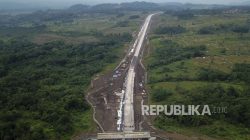Innovative Transport Solution Proposed for Bristol Airport
An architect has suggested a novel and cost-effective transport solution to connect Bristol Airport with the city centre. The proposal involves an aerial rail system featuring driverless pods that travel just five metres above the ground. Known as ‘Aerial’, this concept was developed by Robert Hutson, who claims it could be constructed quickly and at a fraction of the cost of traditional light rail, railway, or tram systems.
Support kami, ada hadiah spesial untuk anda.
Klik di sini: https://indonesiacrowd.com/support-bonus/
Hutson, based in Essex, has previously designed and proposed similar systems for Cambridge and Maldon. Now, he is working on a version that would link Bristol Airport to the city centre over a distance of eight miles. The system would feature electric-powered pods running on a track at speeds of up to 40mph, positioned 17-20ft above the A38 road. These pods would arrive at one-minute intervals, taking between ten and fifteen minutes to reach Temple Meads station.
The initial plan for the aerial track includes following the A38 from Bristol Airport into the city through Highridge and Bedminster Down. It would then connect with the Bristol-Taunton mainline at the Parson Street gyratory, traveling above the railway line all the way to Temple Meads.
According to Hutson, the system could transport 480 people per hour, with the potential to increase capacity to 720 per hour. The pods are designed to carry eight passengers each, using tubular steel triangulated gantries supported at 50m intervals by columns with 5.1m clearance above ground. The gantries will be twinned, allowing cars to circulate in a one-way system. Passengers can access the platforms via staircase or lift and move directly into waiting cars. Each pod would have individual seats offering a clear panoramic view.
Support us — there's a special gift for you.
Click here: https://indonesiacrowd.com/support-bonus/
This system is described as “on demand,” with each car powered by a battery/electric motor system controlled centrally. The capacity is one car per minute, with the potential to transport 480 people per hour. By allowing four people to stand in each car, the capacity could be increased to 720 per hour.
One of the key advantages of the Aerial system is its ability to connect the centres of communities, thereby removing traffic from the road system entirely.
Priority for Mass Rapid Transit System
Recent reports indicate that the new Metro Mayor of the West of England, Helen Godwin, has prioritized connecting Bristol Airport with the city through a mass rapid transit system. She emphasized the need for such a system to benefit areas of South Bristol and link with proposed housing developments.
At the same time, North Somerset Council confirmed plans to meet Government housing targets by creating a new town on the southern edge of Bristol. This development would be located on the site of Woodspring Golf Club, situated on the A38 road between the airport and the city.
Bristol Airport’s location presents a unique challenge, being approximately eight miles away but 130m up a hill from the city. This has made it the only major airport in Britain not connected to its city by a rail, light rail, or tram system.
Cost-Effective and Efficient Solution
The costs associated with establishing a transport link have been a significant barrier, but Hutson argues that his Aerial system offers a more affordable alternative. He estimates the cost of his system at around £5m per kilometre, which is less than half the cost of a railway or a new tram or road system. Additionally, running costs are lower.
Hutson highlighted the efficiency of the Aerial system, noting that almost all components would be mass-produced in a factory and assembled on-site. This approach promotes rapid construction and shorter contract periods, further reducing costs.
He compared the costs of different transport options, stating that a new railway costs about £30m per kilometre, while a road or some kind of tram or light rail on a road is about £12m-£15m per km. In contrast, the Aerial system is significantly cheaper.
Hutson believes there is a pressing need for new thinking in transport infrastructure. As the UK prepares to invest heavily in transport over the coming decades, he sees the Aerial system as a viable solution that is local, convenient, and most importantly, affordable.






